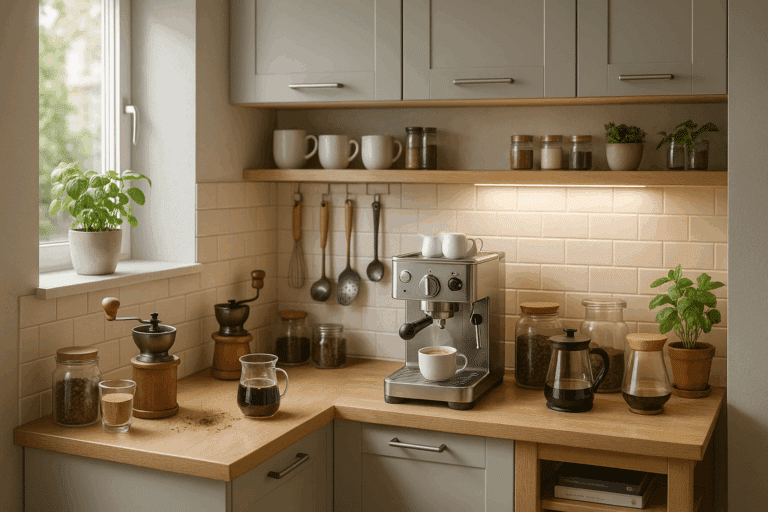In an era where the health of our planet hangs in a delicate balance, the concept of green living emerges not as a mere lifestyle choice, but an imperative for a sustainable future. 💚🌍 As a society, we are shifting from being mere consumers to conscientious stewards of our environment. This transformation is reflected in various aspects of our lives, particularly in the way we design our living and working spaces. So how do we translate this growing environmental consciousness into the design and layout of our homes, offices, and cities? 🏡🏢🏙️
It’s an intricate challenge that merges aesthetics, functionality, and sustainability. As an expert in this field, I’m here to take you on a comprehensive exploration of eco-friendly design principles and strategies. And it’s not just for architects and urban planners. This article is for everyone who cares about our planet and is curious to find out how their living and working spaces can contribute to a more sustainable world. 🌿
We’ll delve deep into the heart of green design principles, elucidating the technicalities while making them easily digestible for everyone. We’ll explore various concepts such as passive solar design, the use of renewable materials, and waste reduction strategies. Furthermore, we’ll delve into the integration of energy-efficient technologies and the importance of local sourcing. 💡🛠️
But that’s not all. We will also examine case studies of successful eco-friendly designs from around the world. From green homes that reduce energy consumption by over 50% to cities that have redesigned their infrastructure for a more sustainable future. 🌍💚
Why should you care about green design?
At first glance, the idea of green design may seem like a niche interest, limited to those with a passion for architecture or environmental science. But if we dig deeper, we can see that its implications are far-reaching and touch on several significant aspects of our daily lives.
Green design is a key player in the fight against climate change. It provides practical solutions to reduce our carbon footprint and conserve precious natural resources. Additionally, green design enhances the quality of our lives. It creates healthier, more comfortable living spaces that connect us with nature. 🏡🌿
The Future is Green
As the dire consequences of climate change become increasingly evident, the need for sustainable solutions is no longer optional. It’s a pressing priority. And green design is at the forefront of this eco-friendly revolution. From homes and offices to public spaces and entire cities, the impact of green design is transformative and far-reaching.
So whether you’re an architect planning your next project, a homeowner considering a renovation, or simply someone who cares about the environment, this article will equip you with the knowledge and insights you need. Get ready to embark on an enlightening journey into the world of green design, and discover how you can contribute to a more sustainable future. 🌿🌍💚
So, tighten your seat belts as we set off on this exciting journey to explore the world of green living and eco-friendly design. Together, let’s envision and build a sustainable future for us and the generations to come.
🍃 Understanding the Essence of Green Living
Green living is not a fleeting trend; it is a lifestyle choice that revolves around minimizing environmental impact and promoting sustainability. It’s about making conscious choices every day to reduce, reuse, and recycle wherever possible. It’s about designing spaces and lifestyles that coexist harmoniously with nature, not against it. Before we delve into how to design an eco-friendly layout, let’s understand the essence of green living.
Green living encompasses a broad range of practices and lifestyle choices, from what we eat and wear to how we travel and build our homes. At its core, it is about making choices that are not just good for us, but also good for the planet. For some, this might mean adopting a plant-based diet, for others, it could mean choosing to live in an eco-friendly home or opting to use renewable energy sources.
Interestingly, green living is not just about reducing our carbon footprint. It is also about enhancing our quality of life. Eco-friendly homes, for instance, are not only good for the environment, but they can also be more comfortable, healthier, and cost-effective in the long run. And who doesn’t want to live in a home that’s cozy, healthy, and economical?
🏡 Designing an Eco-Friendly Layout: Principles and Benefits
Now that we have a foundational understanding of green living, let’s move on to the crux of this discussion – designing an eco-friendly layout. Whether you’re building a new home or remodeling an existing one, incorporating eco-friendly design principles can help create a space that’s sustainable, efficient, and harmonious with the environment.
The key principles of eco-friendly design include optimizing natural light, promoting energy efficiency, using sustainable materials, and integrating nature into the living space. These principles not only reduce the environmental impact of your home but also offer numerous benefits, such as improved indoor air quality, reduced energy bills, and enhanced wellbeing. In the following sections, we’ll delve into each of these principles and provide practical tips on how to implement them in your home.
First, however, let’s take a moment to appreciate the benefits of eco-friendly design. Check out this informative video titled “Why Green Buildings are a must for Sustainable Future” from the YouTube channel Green Building Congress. It beautifully encapsulates the significance and benefits of eco-friendly design.
🌞 Optimizing Natural Light
The first step in designing an eco-friendly layout is optimizing natural light. By allowing more sunlight into your home, you can significantly reduce the need for artificial lighting, thus saving energy and reducing your carbon footprint. Moreover, natural light can enhance the aesthetics of your space, making it feel more open, airy, and inviting.
So, how can you optimize natural light in your home? Simple strategies include installing larger windows, using light colors on walls and floors, and incorporating reflective surfaces in the design. Additionally, you can use light shelves, skylights, and clerestory windows to bring sunlight into darker areas of your home.
Now, you might be wondering, “How much can I really save by optimizing natural light?” To answer this question, let’s take a look at the table below. It provides a comparative analysis of the energy consumption of various lighting options.
| Lighting Option | Average Energy Consumption |
| Incandescent Bulb | 60 Watts |
| Compact Fluorescent Light (CFL) | 14 Watts |
| LED Bulb | 8 Watts |
| Natural Light (Sunlight) | 0 Watts |
As the table illustrates, nothing beats sunlight when it comes to energy efficiency. It is, without a doubt, the most sustainable lighting option available. So, make the most of it!
🔌 Promoting Energy Efficiency
Another crucial aspect of designing an eco-friendly layout is promoting energy efficiency. This involves choosing energy-efficient appliances and systems, using smart technology to manage energy usage, and incorporating renewable energy sources wherever possible.
Energy-efficient appliances, such as Energy Star-rated refrigerators, washing machines, and dishwashers, consume less energy compared to their non-energy-efficient counterparts. Similarly, systems like HVAC (heating, ventilation, and air conditioning) can be optimized for energy efficiency by using programmable thermostats, energy-efficient boilers, and adequate insulation.
Smart technology, like home automation systems, can help manage energy usage more effectively. For instance, smart thermostats can learn your schedule and preferences, adjusting the temperature accordingly to save energy. Moreover, renewable energy sources, like solar panels and wind turbines, can significantly reduce your reliance on non-renewable sources of energy, thus reducing your carbon footprint.
🌳 Integrating Nature into Your Living Space
Lastly, but certainly not least, integrating nature into your living space is a fundamental part of designing an eco-friendly layout. This involves using plants to improve indoor air quality, creating outdoor living spaces, and using natural materials wherever possible.
Plants can act as natural air purifiers, removing harmful toxins from the air and releasing oxygen. Outdoor living spaces, such as gardens, patios, and balconies, can provide a much-needed connection with nature, promoting wellbeing and reducing stress. Natural materials, such as wood, stone, and bamboo, are not only environmentally friendly but also lend a unique aesthetic appeal to your space.
Creating an eco-friendly layout for a sustainable future might seem like a daunting task, but it’s worth the effort. With conscious choices and a little creativity, you can design a space that’s not only good for the environment but also enhances your quality of life. So, are you ready to embrace green living?
Conclusion
In conclusion, as we wind up this comprehensive exploration of the fascinating realm of Information Technology and Engineering, it’s undeniable that these are both pivotal and robust fields. Ranging from the intricate structures of software design, right down to the most minuscule binary digits that make up the digital world, every facet holds a vital place in the grand scheme of things. 👏👏👏
Reflecting back, we started with a deep dive into the fundamental principles of Software Engineering, analysing its concepts, applications, and its critical importance in today’s digitally-driven world. We explored the intricacies of various software development methodologies, such as Agile, Waterfall, and DevOps, each bringing their unique strengths to the table. 🏢💻
On the Information Technology front, we ventured into the world of network systems, data management, cybersecurity and the growing importance of IT in the 21st century. We underlined how businesses, government institutions, and even individuals are leveraging IT to streamline operations, enhance security and achieve maximum productivity. 🌐🔒
This discourse wouldn’t have been complete without touching upon the fusion of IT and Engineering in areas such as AI, Machine Learning, IoT, and Cloud Computing. These cutting-edge technologies are not just shaping the present but are also poised to dictate the future of digital civilization. 🤖☁️
Undoubtedly, this article has only scratched the surface of these vast fields. Yet, the purpose was to provide a solid foundation, ignite curiosity, and inspire you to delve deeper. The power of knowledge lies not just in acquiring it, but also in applying it, sharing it, and continuously learning. 🎓📚
We hope you’ve found this article enlightening and it has added substantial value to your knowledge base. I’d like to encourage you to share it with your peers, friends, or anyone else who might be interested in this topic. Remember, sharing knowledge is the first step towards building a well-informed community. 💼🌍
To dive deeper into any of the topics covered, I strongly recommend checking out the plethora of resources available online, such as ACM Digital Library, IEEE Computer Society, and the W3Schools among others.
In the end, always keep in mind that in the realm of IT and Engineering, the only constant is change. Therefore, the best strategy is to remain curious, keep learning, and stay adaptable. After all, as Alvin Toffler said, “The illiterate of the 21st century will not be those who cannot read and write, but those who cannot learn, unlearn, and relearn.” 👩💻🚀
Feel free to leave your thoughts, questions, or insights in the comment section below. We value your feedback as it helps us improve and grow. Thanks for joining us on this enlightening journey, and keep tuning in for more insightful articles. 🙌👍
Remember, we are all students in the school of life, and learning is a lifelong process. So, stay curious and keep exploring! 🌟🔭



